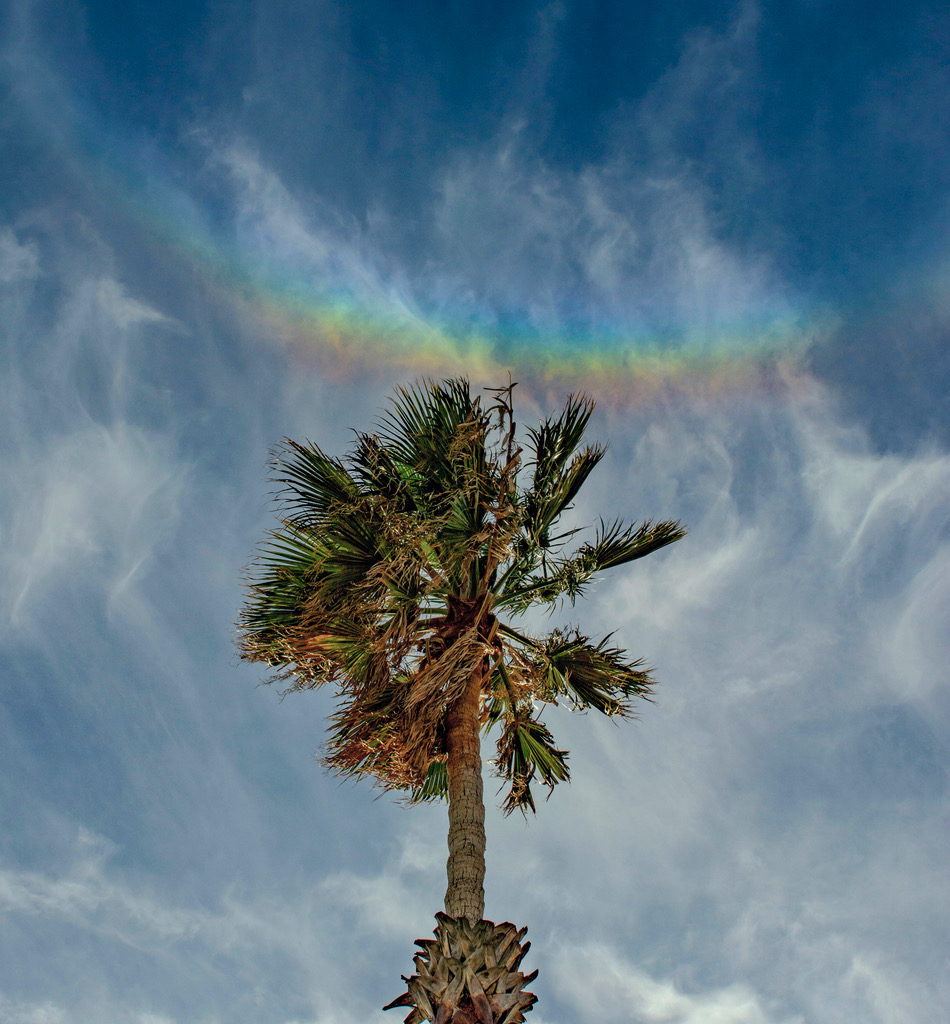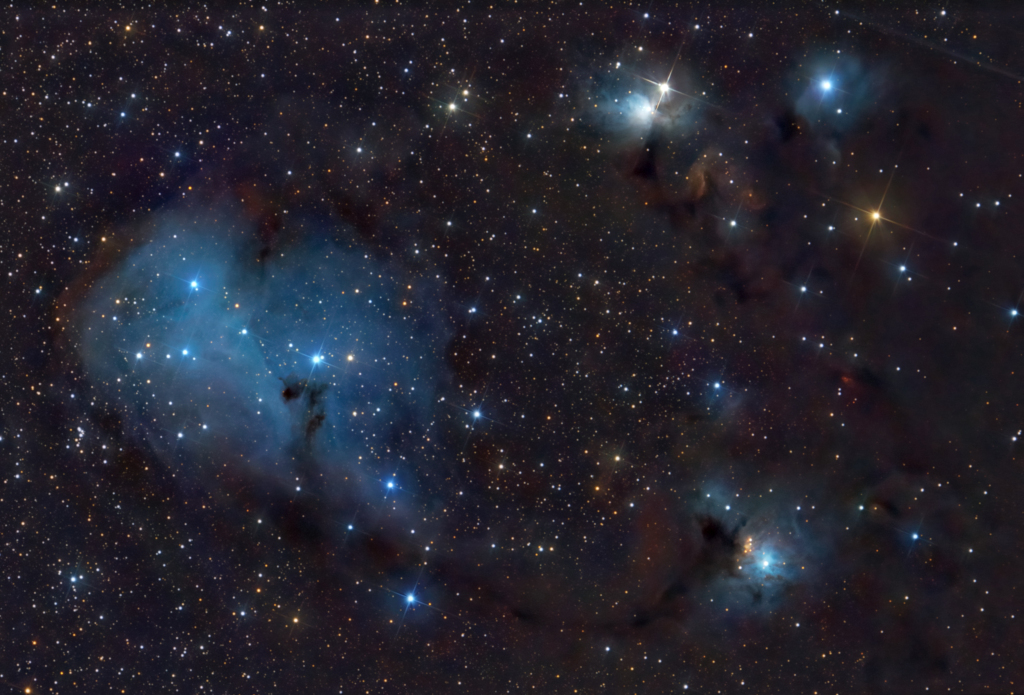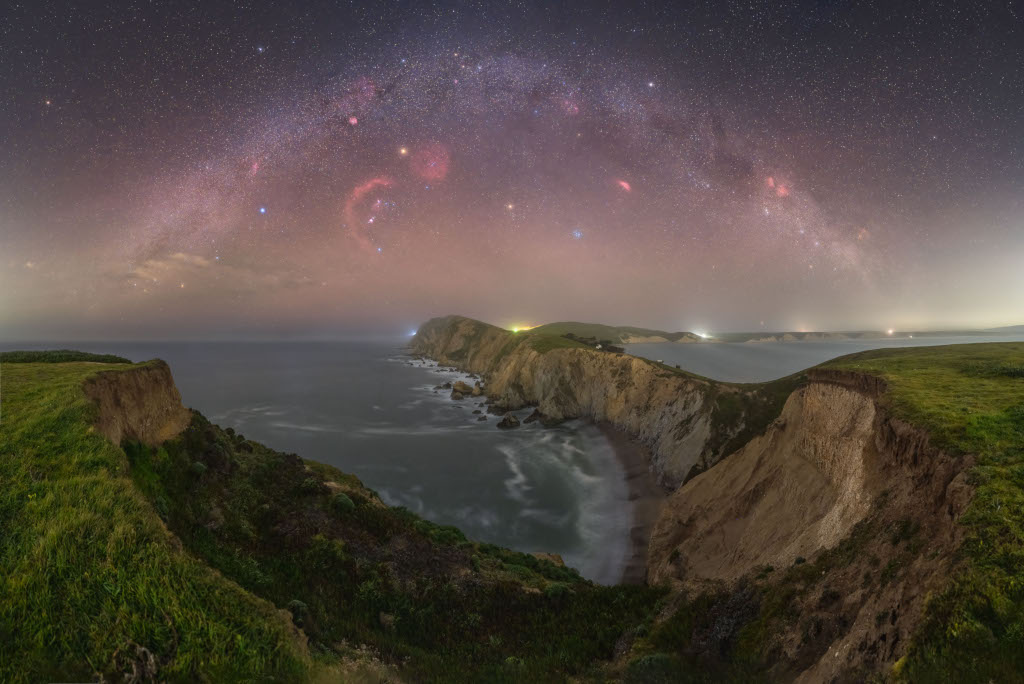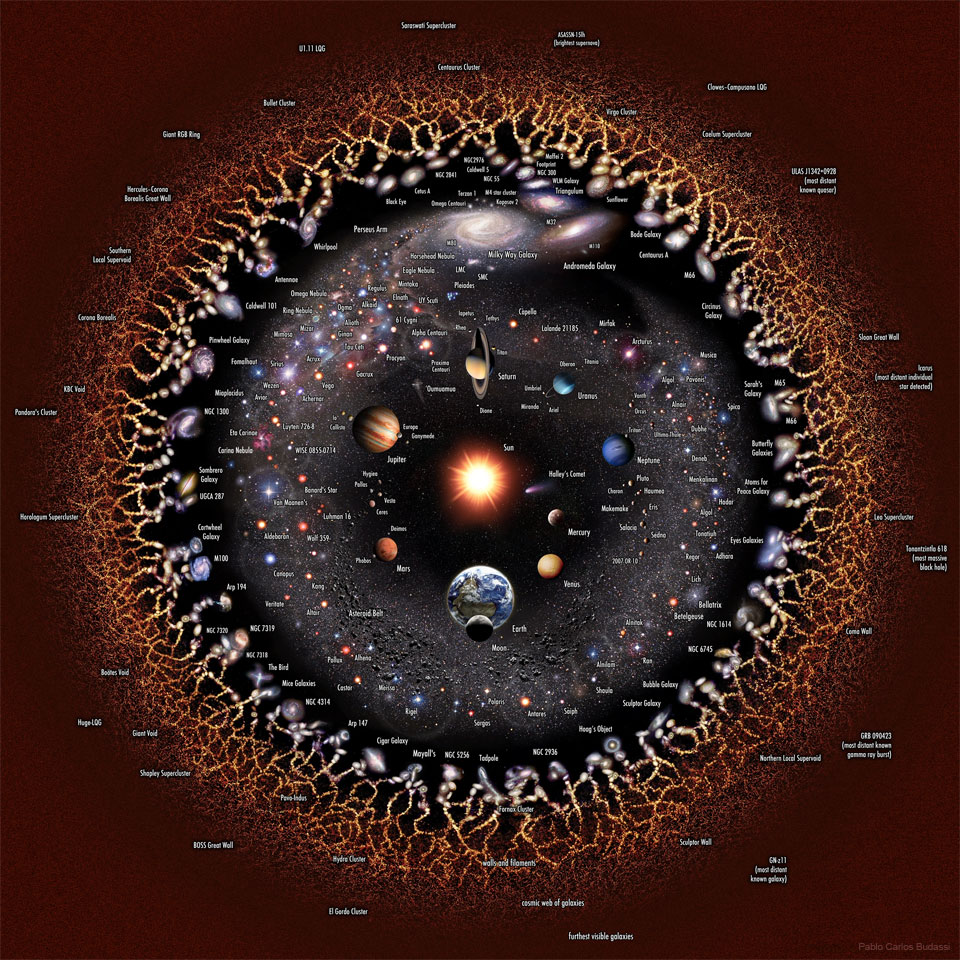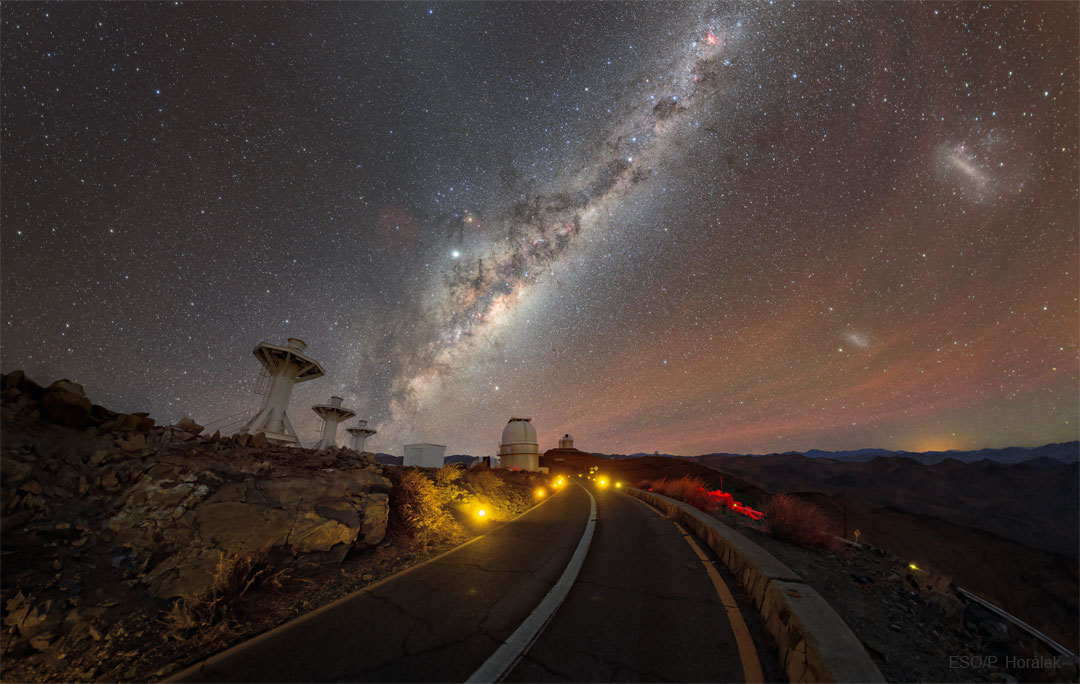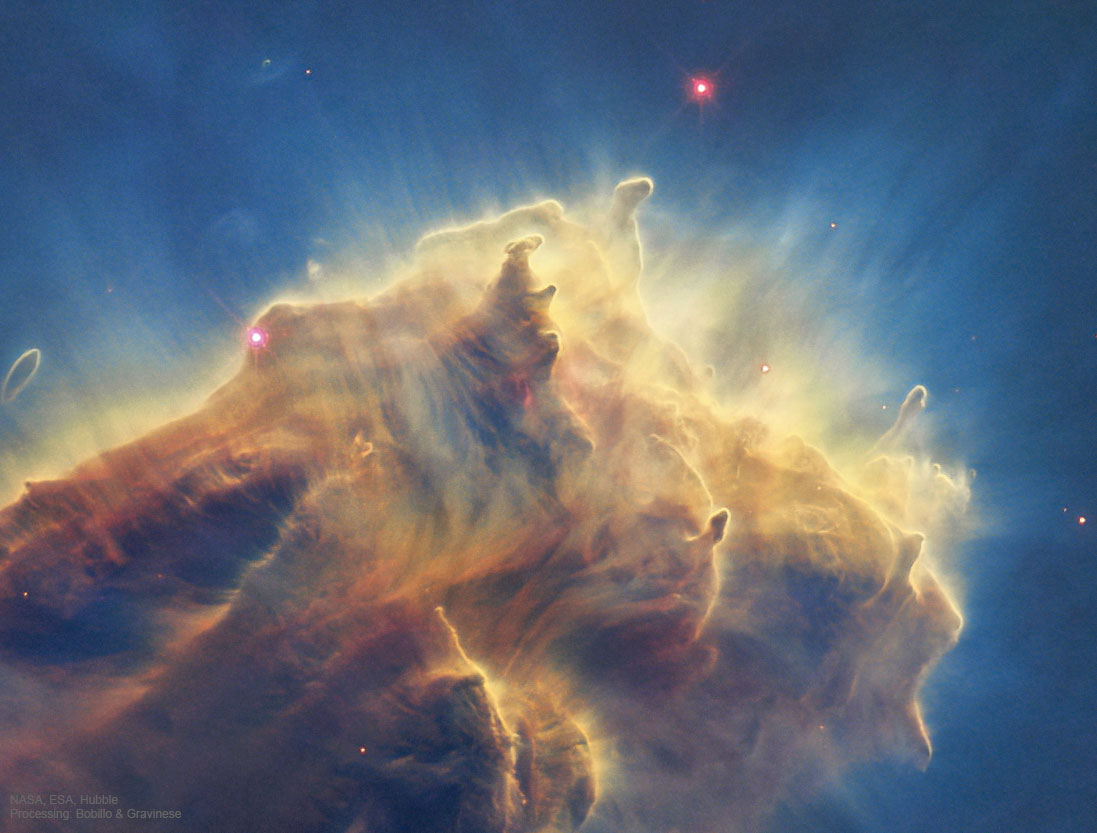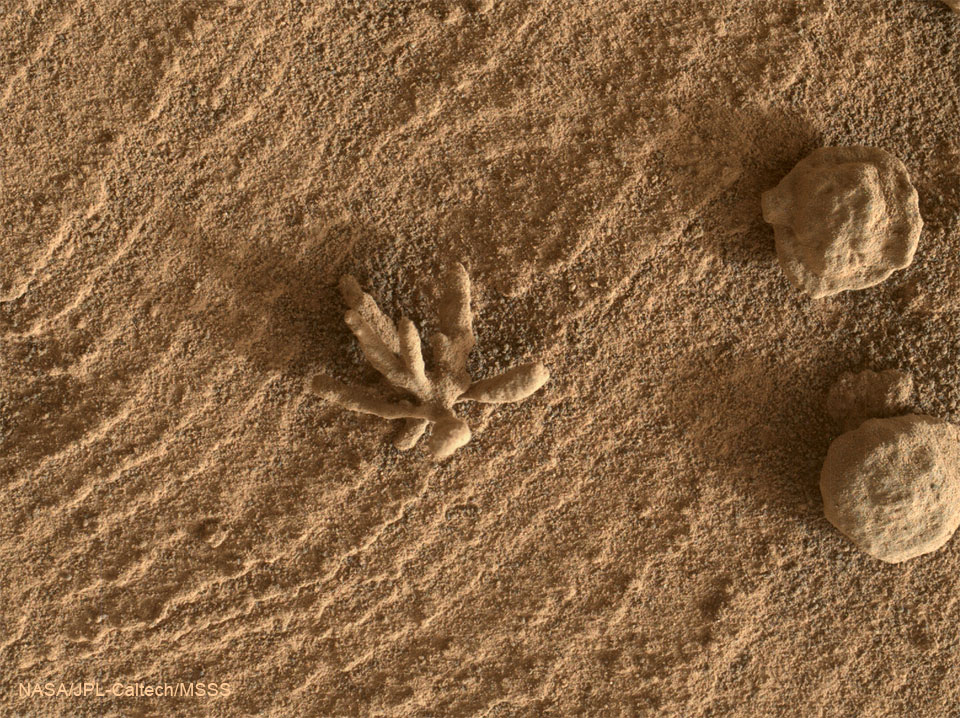Nombre total de pages vues
20/03/2022
19/03/2022
ASTRONOMY - When Rainbows Smile
2022 March 19
Image Credit & Copyright: Marcella Giulia Pace
Explanation: Want to see a rainbow smile? Look near the zenith (straight up) when the sun is low in the sky and you might. This example of an ice halo known as a circumzenithal arc was captured above a palm tree top from Ragusa, Sicily on February 24. The vividly colorful arcs are often called smiling rainbows because of their upside down curvature and colors. For circumzenithal arcs the zenith is at the center and red is on the outside, compared to rainbows whose arcs bend toward the horizon after a downpour. True rainbows are formed by water droplets refracting the sunlight to produce a spectrum of colors, though. Circumzenithal arcs are the product of refraction and reflection in flat hexagonal ice crystals, like the ice crystals that create sundogs, formed in high thin clouds.
18/03/2022
ASTRONOMY - A Filament in Monoceros
2022 March 18
Image Credit & Copyright: Giorgio Ferrari
Explanation: Bluish reflection nebulae seem to fill this dusty expanse. The sharp telescopic frame spans over 1 degree on the sky toward the faint but fanciful constellation Monoceros, the Unicorn. Seen within the Monoceros R1 cloud complex some 2,500 light-years away, bluish IC 447 is on the left, joined by a long dark filament of dust to IC 446 at lower right. Embedded in IC 447 are young, massive blue stars much hotter than the Sun, whose light is reflected by the cosmic cloud of star stuff. Observations reveal that IC 446 also contains a young stellar object, a massive star still in an early stage of evolution. The dark filament of dust and molecular gas joining the two star-forming regions is over 15 light-years long.
17/03/2022
ASTRONOMY - Point Reyes Milky Way
2022 March 17
Image Credit & Copyright: Dan Zafra
Explanation: Northern winter constellations and a long arc of the Milky Way are setting in this night skyscape looking toward the Pacific Ocean from Point Reyes on planet Earth's California coast. Sirius, alpha star of Canis Major, is prominent below the starry arc toward the left. Orion's yellowish Betelgeuse, Aldebaran in Taurus, and the blue tinted Pleiades star cluster also find themselves between Milky Way and northwestern horizon near the center of the scene. The nebulae visible in the series of exposures used to construct this panoramic view were captured in early March, but are just too faint to be seen with the unaided eye. On that northern night their expansive glow includes the reddish semi-circle of Barnard's Loop in Orion and NGC 1499 above and right of the Pleiades, also known as the California Nebula.
MICROPHOTOGRAPHY - Marek Mis - Micrasterias americana
16/03/2022
ASTRONOMY - The observable Universe
2022 March 16
Illustration Credit & Licence: Wikipedia, Pablo Carlos Budassi
Explanation: How far can you see? Everything you can see, and everything you could possibly see, right now, assuming your eyes could detect all types of radiations around you -- is the observable universe. In light, the farthest we can see comes from the cosmic microwave background, a time 13.8 billion years ago when the universe was opaque like thick fog. Some neutrinos and gravitational waves that surround us come from even farther out, but humanity does not yet have the technology to detect them. The featured image illustrates the observable universe on an increasingly compact scale, with the Earth and Sun at the center surrounded by our Solar System, nearby stars, nearby galaxies, distant galaxies, filaments of early matter, and the cosmic microwave background. Cosmologists typically assume that our observable universe is just the nearby part of a greater entity known as "the universe" where the same physics applies. However, there are several lines of popular but speculative reasoning that assert that even our universe is part of a greater multiverse where either different physical constants occur, different physical laws apply, higher dimensions operate, or slightly different-by-chance versions of our standard universe exist.
15/03/2022
ASTRONOMY - A Road to the Stars
2022 March 15
Image Credit: ESO, Petr Horálek (ESO Photo Ambassador, Inst. of Physics in Opava)
Explanation: Pictured -- a very scenic road to the stars. The road approaches La Silla Observatory in Chile, with the ESO's 3.6-meter telescope just up ahead. To the left are some futuristic-looking support structures for the planned BlackGEM telescopes, an array of optical telescopes that will help locate optical counterparts to gravitational waves detections by LIGO and other detectors. But there is much more. Red airglow illuminates the night sky on the right, while the central band of our Milky Way Galaxy slants across the image center. Jupiter can be seen just above the band near the image center, while Saturn is visible just above the 3.6-meter telescope dome. The two largest satellite galaxies of our Milky Way Galaxy, the LMC and SMC, are seen on the far right. The featured image panorama was built up from multiple 15-second exposures that were captured on 2019 June 30. Two days later, La Silla experienced a rare total eclipse of the Sun.
14/03/2022
ART FRACTAL - Définition
Art et fractales : découverte d’un monde infini

ASTRONOMY - Star Formation in the Eagle Nebula
2022 March 14
Image Credit: NASA, ESA, Hubble; Processing & Copyright: Ignacio Diaz Bobillo & Diego Gravinese
Explanation: Where do stars form? One place, star forming regions known as "EGGs", are being uncovered at the end of this giant pillar of gas and dust in the Eagle Nebula (M16). Short for evaporating gaseous globules, EGGs are dense regions of mostly molecular hydrogen gas that fragment and gravitationally collapse to form stars. Light from the hottest and brightest of these new stars heats the end of the pillar and causes further evaporation of gas and dust -- revealing yet more EGGs and more young stars. This featured picture was created from exposures spanning over 30 hours with the Earth-orbiting Hubble Space Telescope in 2014, and digitally processed with modern software by experienced volunteers in Argentina. Newborn stars will gradually destroy their birth pillars over the next 100,000 years or so -- if a supernova doesn't destroy them first.
09/03/2022
ASTRONOMY - A Flower-shaped rock on Mars
2022 March 9
Image Credit: NASA, JPL-Caltech, MSSS
Explanation: It is one of the more unusual rocks yet found on Mars. Smaller than a penny, the rock has several appendages that make it look, to some, like a flower. Although it would be a major discovery if the rock was truly a fossilized ancient Martian flower, there are less spectacular -- and currently preferred -- explanations for its unusual structure. One theory that has emerged is that the rock is a type of concretion created by minerals deposited by water in cracks or divisions in existing rock. These concretions can be compacted together, can be harder and denser than surrounding rock, and can remain even after the surrounding rock erodes away. The flower structure may also be caused by crystal clusters. The small rock, named Blackthorn Salt, has similarities to previously imaged Martian pebbles. The featured image was taken by the Curiosity rover on Mars in late February. Scientists will continue to study data and images taken of this -- and similar -- surprising Martian rocks.
ASTRONOMY - Mystery: Little Red Dots in the Early Universe
2025 December 24 Mystery: Little Red Dots in the Early Universe Image Credit: NASA , ESA , CSA , STScI , JWST ; Dale Kocevski ( Colb...
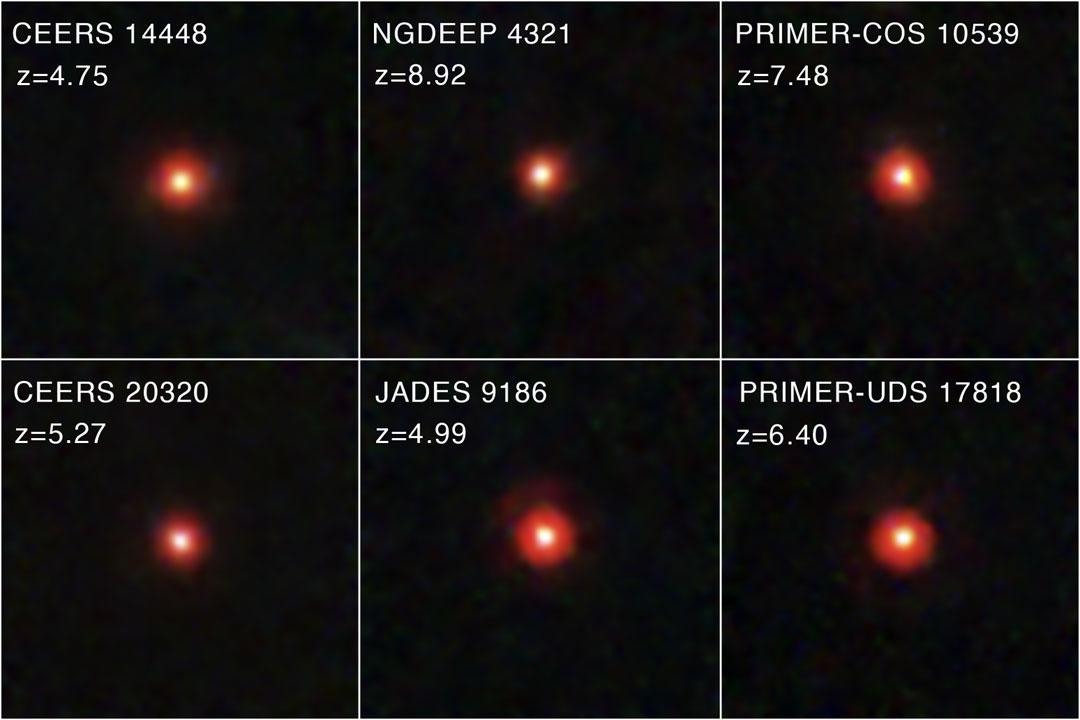
-
2022 September 26 All the Water on Planet Earth Illustration Credit: Jack Cook, Adam Nieman, Woods Hole Oceanographic Institution ; Data ...
-
2025 May 11 The Surface of Venus from Venera 14 Image Credit: Soviet Planetary Exploration Program , Venera 14 ; Processing & Copyri...
